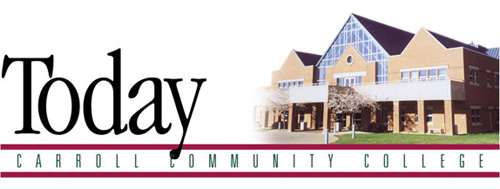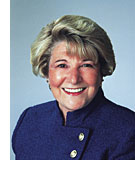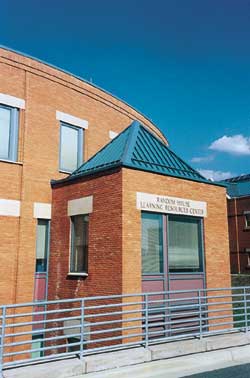
![]()
Contents
President Announces Strategic Initiatives for FY2001 and FY2002
New State Scholarships to Benefit Transfers from Carroll
Book Fair Set for November 11th
Self Study Completed, Team to Visit November 12-15
Enrollment Increases Over 13 Percent
Stock Gifts Make End-of-year Tax Sense
The Learning- centered College
![]()
President Announces Strategic Initiatives for FY2001 and FY2002
 At
the July meeting of the Board of Trustees, college president Dr. Faye
Pappalardo presented the college community with its priority goals for
the next two years. To guide area planning and collegewide budgeting,
the college each year adopts a set of “strategic initiatives”
developed by the president with feedback from the Planning Advisory Council.
They represent the college’s areas of emphasis for the next two years.
The following nine strategic initiatives were accepted by the Board and
are in place for fiscal years 2001 and 2002:
At
the July meeting of the Board of Trustees, college president Dr. Faye
Pappalardo presented the college community with its priority goals for
the next two years. To guide area planning and collegewide budgeting,
the college each year adopts a set of “strategic initiatives”
developed by the president with feedback from the Planning Advisory Council.
They represent the college’s areas of emphasis for the next two years.
The following nine strategic initiatives were accepted by the Board and
are in place for fiscal years 2001 and 2002:
1. Initiate an assessment program to assure institutional integrity. During the spring of 1999, work groups of the Planning Advisory Council developed 72 indicators of institutional effectiveness covering seven assessment domains: access and opportunity, student development and learning, baccalaureate preparation, workforce development, teaching and learning environment, community enrichment and lifelong learning, and resource development, allocation, and use. The proposed measures were accepted by the president and approved by the college’s Board of Trustees in July 1999. The measures were developed without regard to the college’s current ability to provide the data required. A major goal for the next two years is to develop the data systems necessary for full implementation of the performance indicator system.
2. Implement the 2000-2003 Academic Plan. The Academic Plan was developed by the faculty under the leadership of the Vice President of Academic and Student Affairs. The major objectives of the plan are grouped under three areas: curriculum and program development, delivery systems, and quality of learning. Curricular development objectives include infusing core competencies in the general education curriculum, developing new programs in health and information technologies, adding additional transfer options, instituting an allied health consortium with neighboring community colleges, expanding articulation agreements with four-year colleges, continuing participation in Maryland OnLine and the Maryland Community College Teleconsortium, convening program advisory committees, and increasing partnerships with the county schools. Delivery objectives include expanding anytime-any place-any pace courses and the use of learning communities. Objectives for learning quality include establishing an outcomes assessment team, expanding the activities of the Teaching and Learning Center, adding laboratory components to developmental classes, increasing on campus and online learning support services, lowering class size in selected courses, and creating a scholarship-supported, Carroll Scholars Program.
3. Increase any time, any place, any pace learning options. The college has steadily increased its distance education offerings in recent years, through both courses developed by Carroll faculty and via teleconsortia participation. The college plans to develop an online degree program and continue expansion of asynchronous learning options to meet the needs of students with time and distance constraints.
4. Expand community and workforce development efforts. The vision statement for the college’s Continuing Education and Training area is to become “the premier provider of dynamic and relevant workforce train ing and professional development, and the purveyor of enriching, informative, and timely non-credit lifelong learning experiences for the Carroll County community.” Non-credit FTE enrollment in FY2000 was at an all-time high. Contract training was provided to 90 clients covering nearly 7,000 students. The college has several alliances with corporate partners for delivery of national training products, such as Achieve Global/Zenger Miller, Ziglar Education Systems, Fast Trac II, and I/Tech. New programs for 2001 include an entry-level police academy and a plant production tissue culture facility. Challenges ahead include competing in the exploding e-learning environment, acquiring adjunct faculty in technical areas, meeting the specialized training needs of small businesses in a cost effective manner, and marketing.
5. Implement the FY2001-FY2002 Marketing Plan. The college’s marketing plan was developed during 1999 by a collegewide Marketing Team. A comprehensive marketing research program, including secondary research, a needs assessment of the local business community, a countywide telephone survey of adult residents, surveys of new and continuing students, and focus groups with high school students, adult learners, and business clients, provided a rich database for the Team’s recommendations. Six major marketing initiatives were recommended by the Team and approved by the president for implementation: (1) Implement “The Better Freshman Year” campaign targeted at county school students, parents, teachers, and counselors; (2) promote credit and noncredit information technology training courses and programs for both career entry and job skill upgrading and certification; (3) promote county business development contract and open-enrollment training; (4) implement a municipality outreach program; (5) begin process of becoming an e-commerce organization; and (6) design and implement a collegewide graphic identity program.
6. Develop an integrated enrollment management plan. Effective enrollment management begins with prospective students’ initial inquiries and continues through to maintaining relationships with alumni and former students. College efforts to enhance student persistence through targeted interventions and other retention strategies are major components of enrollment management. The college is developing a data warehouse to enable improved longitudinal tracking of students for better retention analysis.
7. Enhance service to students, clients, and community, including through the effective use of Internet and Web technologies. The college will convene a Web Technologies Retreat in fall 2000 to further develop an integrated Internet strategy for the college. The college bookstore went online in summer 2000. Web registration is planned for fall 2001 implementation. Expanded distance learning courses and Web enhancements to on-campus course delivery are planned.
8. Expand and enhance faculty and staff professional development. Keeping pace with the new ways of working and learning requires ongoing professional development. Responsibility for directing professional development of the college’s faculty and staff has been assigned to Sherry Glass, Executive Assistant to the President. A professional development needs assessment survey was completed and used in preparing a collegewide staff development plan, which was shared with the Planning Advisory Council. The Teaching and Learning Center supports full-time and adjunct faculty with teaching workshops, collaborative faculty projects, and academic networking and conference participation.
9. Create and initiate a collegewide development plan for the Foundation. Being a small institution means resources from the traditional funding sources (county, state, and students) are limited, restricting or delaying implementation of many innovative ideas developed by college faculty and planning committees. Limited resources also constrict the ability of the college to introduce new academic programs. For these reasons, the college has made a commitment to increasing the effectiveness of its Foundation fundraising. Jacqueline Harrington, the college’s Executive Director of Institutional Development and College Foundation, will lead this effort to increase support for the college.

![]()